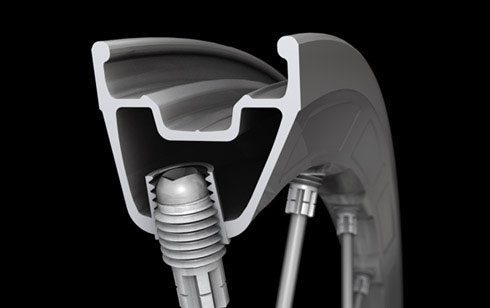 Component: Mavic Crossmax SX wheels
Component: Mavic Crossmax SX wheels
Intended Use: All-mountain/Freeride
Weight: 1,920g pair; 910g front, 1,010g rear
Disc Type: 6-bolt
UST Tubeless
Rim: Maxtal
Spokes: Zicral aluminum alloy
Free wheel: FTS-S
Rider: 6’0”, 175 lbs.
Test Location: Tahoe, CA
Test Duration: Four years, summer and fall, approximately 10-15 hours a week.
Tested on: 2008 Giant Reign 0
Forks used: 2008 Fox Talas 32, 2010 Fox Float 36 160mm
MSRP: $899
Upgrading your bike’s wheelset is one of the best ways to improve your riding experience; some high-end bikes come with worthy hoops spec’d on them, but many don’t. Coughing up $600-$1,000+ for wheels may seem crazy, but it could easily be worth the investment in the long term.
In 2002 I bought my first dual-suspension mountain bike, a Trek Fuel 100. After about a month of heavy use, my rear wheel had been trued four or five times and was already knocked out of round. Later that summer I bought my first set of Crossmax wheels and promptly learned the difference a high-end wheelset could make.
Fast forward to the summer of 2008, when I bought a Giant Reign 0. While this bike has proven to be my favorite of all time, the OEM wheelset left a lot to be desired. Again, after a month or two of riding, I beat the flimsy wheels into submission. I ponied up for a brand new pair of Mavic Crossmax SX wheels, and I was happily on my way. I’ve been riding this same wheelset ever since.

Mavic makes three models of Crossmax wheels, the SLR (race), the ST (trail), and the SX (all-mountain/freeride), which is designed to meet the demands of modern all-mountain riders for everything short of full-on downhilling.
One of the first things you’re likely to notice about Crossmax wheels is how light they are. While heavier than the SLR or ST, my 2008 SXs weighed in at a shade over 1,900 grams—not bad for the stoutest all-mountain wheels I’ve ever used. At first the wheels seem almost too light, like there was no way they would be able to handle the abuse they’re designed for. But as an owner of two previous sets of Crossmax wheels, I was confident that they would be up to the task of hurtling me down mountainsides at unreasonable speeds.
Out of the box, the Mavic wheel’s tubeless compatibility was impressive. The Mavic rims come completely sealed (except for the valve hole, which gets sealed with an included tubeless valve stem) because the wheel’s proprietary spokes and nipples thread into the rim from the outside (which Mavic calls their Fore technology). Simply put a couple of tubeless-compatible tires along with a couple of doses of Stan’s sealant on the rims, and inflate.

One turn into my first ride on the SXs, and I noticed the stiffness of the wheels. There is little to no perceptible lateral flex to the wheels whatsoever, a very noticeable attribute when compared to the flexy OEM wheels that came stock on my Reign. The wheel’s stiffness instantly tightened up my whole ride and seemingly everything about my bike functioned better with these lightweight, silent, and burly wheels.
Over the course of four years of riding, I have put my SXs through the wringer. Thousands of miles of riding, hundreds of crashes, lots of abrupt rock edges—you name it—and this wheelset has taken it. My SXs are as stiff and as true today as the day I bought them.
Over the years, though, I have broken my fair share of the proprietary Zicral spokes. The Zicral alloy will bend a good ways before breaking, and you can ride on a bent SX spoke for some time. Luckily, my local shop carries spokes for all models of Crossmax wheels, so replacing spokes has never been an issue for me, as it might be for others.
Replacing the spokes is simple (unless it’s on the rear drive side, and you have to take off your cassette) because a spoke wrench is included with your wheels to fit the Crossmax-specific nipple. If you are prone to breaking spokes and own some Crossmaxes, I would recommend purchasing several in advance so that you have them available when needed. Although not ideal, I found that you could ride an SX wheel with a broken spoke for days or longer, if necessary.
Mavic’s Maxtal rims have truly taken a beating as well. After being slammed on sharp rock edges and coming up short on small gap jumps for years, my SX rims don’t have a single dent in them, and my wheels are still perfectly in round. When I flat my tubeless tires, it is simple to pull the tubeless valve stem, slap a tube in my tire, and be on my way.

seems a bit too stoke-a-licious for a set of mediocre wheels, of course your 1900 gram wheels are bomber. and havin to service your freehub that much sucks. this is the beginning of blister’s return to normal gear reviews. its good, its good, its good, gloss over a big problem, its good, its good its good. The reason you have any readers is the true dirt on how our products fail…
Dear “blah,”
Huh?
Jeremy writes a longterm review (4 years) of a wheel that is still true and un-dented—that’s pretty impressive. He doesn’t “gloss over” any “big problems,” he details very specifically the issues he had with the wheel, and explains how he dealt with those issues.
Seems like you were hoping for a tirade rather than an honest assessment and useful information that will allow readers to make their own decisions?